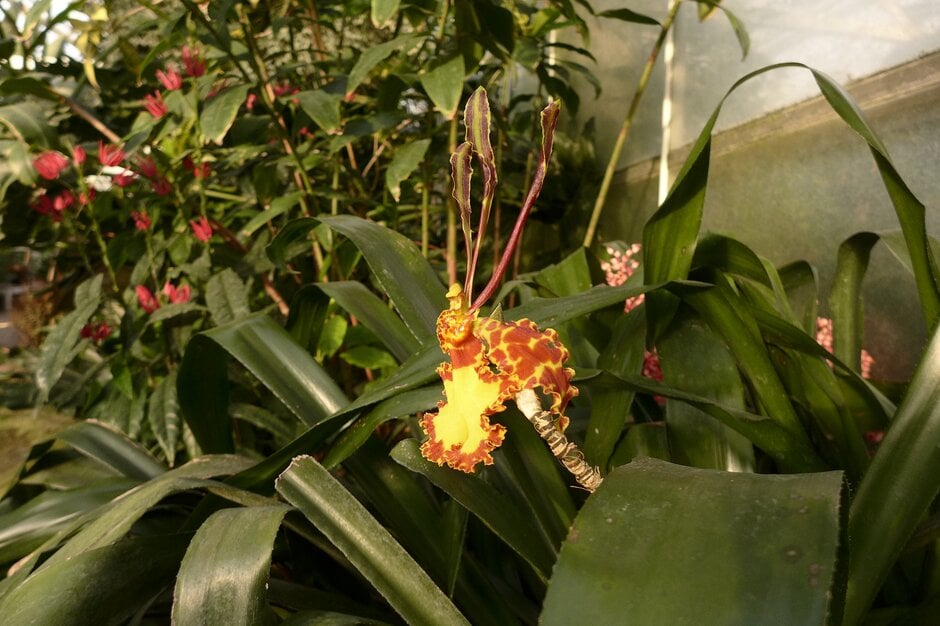Oncidium papilio
butterfly orchid
A medium-sized, warm-growing epiphytic orchid. New growth emerges from the base of swollen stems (pseudobulbs). Each pseudobulb is round, approximately 3-5cm large, carrying single, 15 - 20cm long leaf. Each rigid leaf is dark green mottled with purple or brown-red. New flowering stems emerge from the base of young, mature pseudobulb and carry numerous, flowers developing in succession. Each upright stem can measure up to 120cm. Flowers are unusually shaped, 13-15cm large and yellow with a reddish-brown pattern.
Size
Ultimate height
0.5–1 metresTime to ultimate height
5–10 yearsUltimate spread
0.1–0.5 metresGrowing conditions
Moisture
Moist but well–drained, Well–drainedpH
NeutralColour & scent
| Stem | Flower | Foliage | Fruit | |
| Spring | Yellow Brown | Green Purple Brown | ||
|---|---|---|---|---|
| Summer | Yellow Brown | Green Purple Brown | ||
| Autumn | Yellow Brown | Green Purple Brown | ||
| Winter | Yellow Brown | Green Purple Brown |
Position
- Partial shade
Aspect
East–facing or North–facing or West–facing
Exposure
Sheltered Hardiness
H1ABotanical details
- Family
- Orchidaceae
- Native to GB / Ireland
- No
- Foliage
- Evergreen
- Habit
- Columnar upright, Clump forming
- Potentially harmful
- Skin allergen. Wear gloves and other protective equipment when handling
- Genus
Oncidium are a large genus of epiphytic orchids; mature plants form clumps of ovoid to conical pseudobulbs, each with 1-3 mid-green, variably-shaped, leathery leaves arising from the tips. Flower panicles from the bases of the pseudobulbs widely differ in colour and shape
- Name status
Correct
- Plant range
- Trinidad, Venezuela, Colombia, Peru
How to grow
Cultivation
Grow in an open bark-based orchid compost with addition of perlite, sphagnum moss or coir. Provide enough bright filtered light, but keep away from direct sunlight or a heating source. Ideal temperatures are around minimum 14°C at night and up to maximum 30 °C during day. Water regularly, when the pot feels light when lifted. Ensure that all water drains away, preventing the plant sitting wet. Orchid fertiliser can be applied regularly throughout the growing season. Reduce watering and feeding in winter months. For more notes on cultivation, see oncidium orchid (warm) cultivation
Propagation
Propagation by seed is only possible in a controlled laboratory environment. Mature plants may be divided when the plant overgrows its container. Each division should have at least 3 older pseudobulbs with a sufficient amount of stored energy and water, to support new growth and reduce stress after repotting.
Suggested planting locations and garden types
- Houseplants
- Conservatory and greenhouse
Pruning
No pruning required. Do not remove flowering stems, as they will re-flower if left undisturbed.
Pests
May be susceptible to mealybugs, aphids and scale insects.
Diseases
Generally disease-free. Poor air movement may cause bacterial or fungal rots. Good hygiene practice and sterilising cutting tools prevent the spread of virus diseases.
Get involved
The Royal Horticultural Society is the UK’s leading gardening charity. We aim to enrich everyone’s life through plants, and make the UK a greener and more beautiful place.
